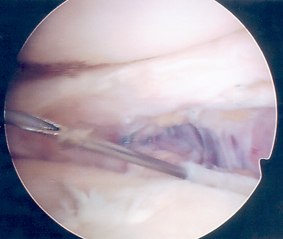 Anatomy
Anatomy Stability of the knee is achieved by a combination of the bony shape of the knee and the various muscle and ligament groups that span across the knee. Around the knee the most important ligaments are the collateral ligaments. These are the two major ligaments that originate on the femur (thighbone) and reach the tibia (leg bone) and are outside the joint capsule itself. The lateral collateral is situated on the outside of the knee and the medial collateral on the inner aspect of the knee.
The other two major ligaments involved are the anterior and posterior cruciate ligaments. These two ligaments are situated centrally within the joint itself. The anterior cruciate ligament runs from the front of the tibia to the back of the femur and the posterior cruciate ligament runs in the opposite direction.
Spectrum of injury
All these ligaments can have a minor injury such as a sprain, but far more troublesome are the complete ruptures or tearing of the ligament. Tears of the ligaments may follow fairly forceful injuries and the greater the amount of the force, the more the chance that one or more ligaments may be ruptured.
The anterior cruciate injury is often accompanied by profound swelling. This is normally confined to within the knee and often there is little in the way of external bruising. External bruising implies that the capsule surrounding the joint has been damaged,implying that there has been a more serious injury or one of the external structures around the knee (for example the medial collateral ligament) has been damaged .
Investigation
The degree of damage to the knee following an injury may be obvious just from the clinical examination. However examining the acutely injured knee may be difficult and inconclusive if there is still a lot of swelling or the knee is painful. X-rays may help show any accompanying bone injury such as a fracture where the ligament has been torn off the bone and takes a fragment of the bone with it (an avulsion fracture).
More commonly an MRI scan is required. Even this may give a misleading view (the immediate aftermath of a major ligament injury may cause such a lot of swelling around the ligaments that it may not be possible to say accurately if the ligament is torn or not. A definitive opinion in some situations may require an examination of the knee under a general anaesthetic and an arthroscopy of the joint.
Surgery
Not all ligament injuries need surgery. The commonest surgery needed is the reconstruction of a ruptured anterior cruciate ligament (ACL). It is extremely unusual to be able to repair the ruptured tissue and there are many ways that reconstruction with a form of graft can be successfully achieved.
A variety of grafts can be used from the person's own body. These include the "bone-patella-bone graft" where the middle third of the patella tendon is taken along with a bone block at each end (one from the tibial attatchment and the other from the patella). This graft is then threaded through holes in the tibia and femur, which enter the joint at the site of the ACL attatchment. By doing this the line of the original ACL, knee stability is restored. The bone ends of the graft are then screwed to the bone of the tibia and femur and this fixes them. The other method is using the hamstrings tendons from the affected leg. Once the graft is obtained then the same holes are drilled and the graft fixed.
Hospital stay is about two to three days and the you are discharged fully weight bearing . Although contact sport is not allowed for 8 to 9 months after the operation, you are rapidly mobilized and spend considerable time in the gym following surgery, rebuilding your strength.
Back to top